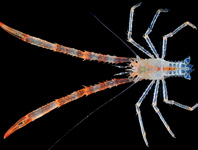Abstract
Prokofiev (2015a) described two new genera and species of Amblyopinae and reported new amblyopine records from waters off Indonesia, the Philippines, and Vietnam. In reviewing Prokofiev’s figures and reading the descriptions of his new genera, Biendongella Prokofiev, 2015 and Sovvityazius Prokofiev, 2015, it appeared likely that these new taxa were based on species also under examination by Koichi Shibukawa and me. However, some differences existed between our specimens and those described by Prokofiev in the pterygiophore formula (DF), the presence/absence of hypural 5, and the number of epurals. The data and information on these characters were not abundantly clear from the text and clarification was needed. For example, on page 786 of Prokofiev (2015a) the following diagnostic feature of Biendongella was provided, “DF 3 1221, vacant interneural gap between spined and soft parts of D present; two first pterygiophores of soft part of D each located in its interneural gap…”. Similar wording exists for Sovvityazius on page 789, “DF 3 1221, vacant gap between spined and soft parts of D present; two first pterygiophores of soft part of D each in its interneural space…”. As for hypural 5 and the number of epurals, the same statement is given for both Biendongella and Sovvityazius on pages 786 and 789, respectively, “Hypural 5 and epural 2 absent.” These character states struck me as remarkable as they are atypical for amblyopines. With respect to the DF character above, amblyopine gobies with a pterygiophore formula of 3-1221 have no interneural gap and the interneural space immediately posterior to the pterygiophore of the ultimate spinous ray contains two pterygiophores (Murdy 2011). As for the latter characters, hypural 5 and two epurals are present in amblyopine gobies (Shibukawa and Murdy 2012). In a detailed email to Prokofiev, I asked for clarification of these discrepancies and whether Biendongella and Sovvityazius have the amblyopine synapomorphy of the ultimate pterygiophore supporting a single ray (Murdy & Shibukawa 2001), which was not mentioned in the description of either genus.
References
Birdsong, R.S., Murdy, E.O. & Pezold, F. (1988) A study of the vertebral column and median fin osteology in gobioid fishes with comments on gobioid relationships. Bulletin of Marine Science, 42, 174–214.
Murdy, E.O. (2011) The Systematics of Amblyopinae. In: Patzner, R., Van Tassell, J.L., Kovacic, M. & Kapoor, B.G. (Eds.), The Biology of Gobies. Science Publishers, Enfield, New Hampshire, pp. 107–118.
https://doi.org/10.1201/b11397-10Murdy, E.O. & Shibukawa, K. (2001) A revision of the gobioid fish genus Odontamblyopus (Gobiidae: Amblyopinae). Ichthyological Research, 48, 31–43.
https://doi.org/10.1007/s10228-001-8114-9Murdy, E.O. & Shibukawa, K. (2002) Redescription of the gobiid fish genus Pseudotrypauchen (Gobiidae: Amblyopinae) and its significance in amblyopine phylogeny. Marine and Freshwater Research, 53, 253–258.
https://doi.org/10.1071/MF01116Murdy, E.O. & Ferraris, C.J. (2003) Gymnoamblyopus novaeguineae, a new genus and species of worm goby from Papua New Guinea (Gobiidae: Amblyopinae). Zootaxa, 150, 1–6.
Prokofiev, A.M. (2015a) An overview of gobies of the subfamily Amblyopinae (Gobiidae) from the western South China Sea (Vietnam and Indonesia) and Pacific waters of the Philippines. Journal of Ichthyology, 55, 683–791.
https://doi.org/10.1134/s003294521506017x
Prokofiev, A.M. (2015b) An overview of gobies of the subfamily Amblyopinae (Gobiidae) from the western South China Sea (Vietnam and Indonesia) and Pacific waters of the Philippines. Voprosy Ikhtiologii, 55, 655–663. [in Russian]
Shibukawa, K. & Murdy, E.O. (2012) A redescription of the eel goby Trypauchenopsis (Gobiidae: Amblyopinae) with comments on relationships. Copeia, 2012 (No. 3), 527–534.
https://doi.org/10.1643/ci-11-034

